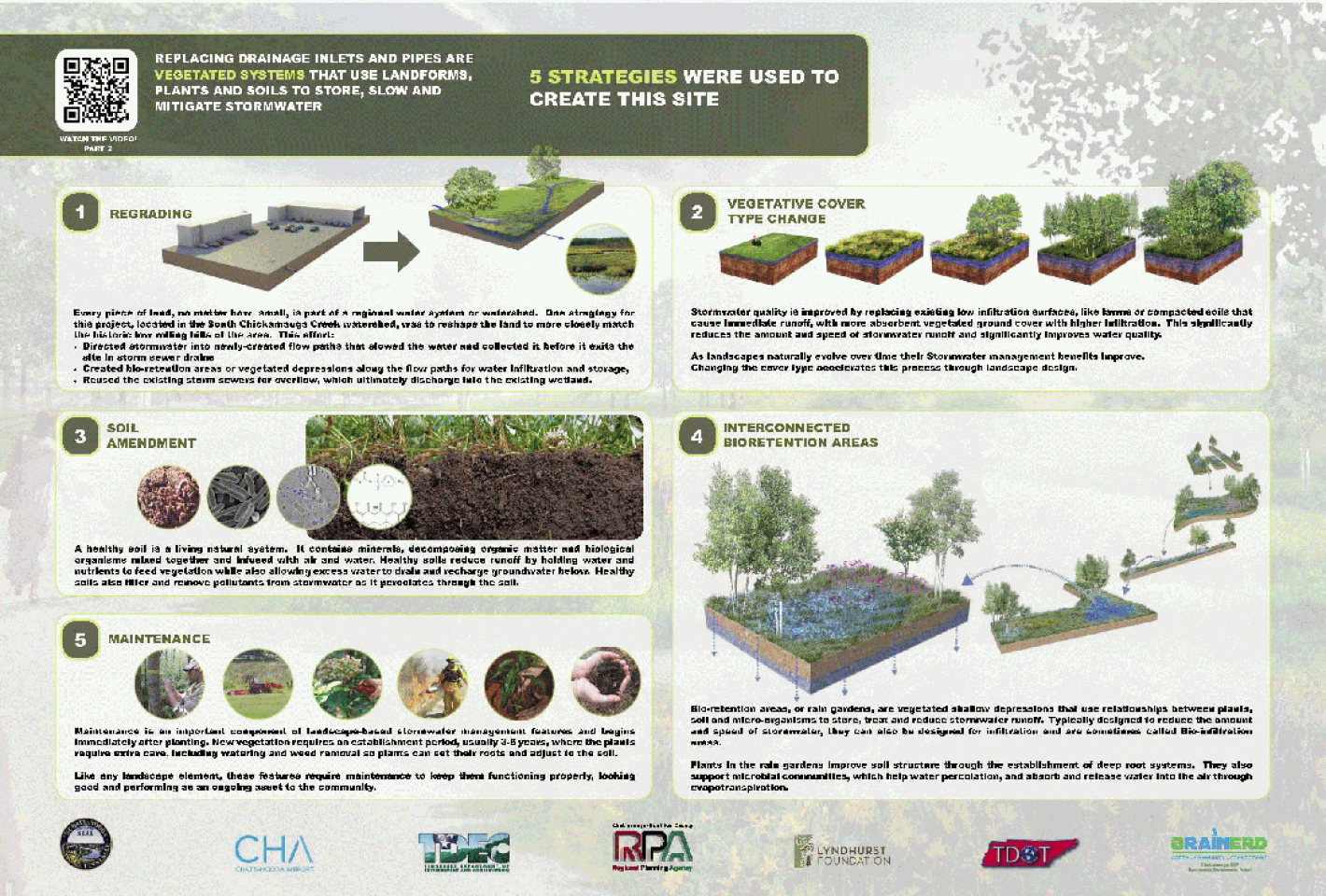What is Green Infrastructure?
Green infrastructure is a form of Low Impact Development (LID) that utilizes vegetation and natural hydrologic processes to manage and treat stormwater.
Main Goal
The goal of green infrastructure is to capture rainwater where it falls in urban spaces, providing benefits for both the community and environment.
Benefits
Green infrastructure is beneficial for the environment and society as it catches pollutants and cleans water, decreases runoff volumes and adds aesthetic value to neighborhoods, parks, and residences.
Functional Design in Green Infrastructure
- Green infrastructure are not intended to look like traditional gardens
- These plants are working! While they do add beauty, they are working hard to uptake & transpire water, so they are functional pieces that are integral to the infrastructure
- These devices are created to mimic natural processes that have been disturbed by humans with the addition of impervious surfaces like roofs, parking lots, and roads
Image

Why Is Green Infrastructure Important?
With aging infrastructure, increasing populations and a need for results that are collaborative and efficient with financial resources, green infrastructure is becoming the standard for stormwater management throughout the country.
Origins of Green Infrastructure
Whether encouraged by compliance, community activism or natural disaster response, communities are creating natural environments for proactive management of urban waters. As small as rain gardens or raised garden beds and as large as regional corridors or parks, green infrastructure endeavors are varied and individual.
Examples at Different Scales
On the localized scale, rain gardens or bioretention ponds, wetlands, riparian zones, permeable pavement, green roofs, rainwater harvesting, sidewalk trees and urban agriculture are all examples of green infrastructure. On the regional scale, green infrastructure preserves, conserves and restores natural landscapes and is often connected to corridors for people and wildlife.
How Can I Help?
Catch the rain at your house, support urban gardens, and dissipate or infiltrate the rainwater hitting your property as much as possible. We have programs that support & can potentially help fund green infrastructure projects, such as:
- RainSmart for residential rain gardens & rain barrels
- Green Grants for businesses & non-single family residential
For more information on this topic, see the Environmental Protection Agency or American Rivers definitions of green infrastructure.
Green Infrastructure Projects in Chattanooga
Brainerd Airport SEP
This project is the result of a Supplemental Environmental Project (SEP) developed by the City of Chattanooga (City) Stormwater Program to address some permit legacy problems with Tennessee Department of Environment and Conservation (TDEC).
This was a project resulting from a stakeholder process in the Eastgate community of Brainerd. It was designed as a demonstration area to test the feasibility and the effectiveness of the City's new Runoff Reduction Standard.
Goals
We hope the resulting Green Infrastructure Retrofit Project for the Brainerd Community will provide a model for retrofitting the entire city, while simultaneously addressing the social, cultural and economic issues and characteristics of each designated district.
While separately administered and funded, this project is intended to work in conjunction with the creation of city-wide Standards for Runoff Reduction, this pilot project will demonstrate the effectiveness of the program.
Benefits
It has a number of advantages for a demonstration district scale project, including:
- Stakeholders with a variety of incomes, lifestyles, ages and ethnic backgrounds
- A wide range of land uses from airports to golf courses and from small retail establishments to big box commercial and shopping malls of different ages and designs
- Brainerd Road is a large central public arterial
The Three Tasks
Task 1 – Green Infrastructure Strategic Plan Development
The process required for the implementation of new standards of land development in Chattanooga requires a district scale assessment of physiographic, hydrologic and cultural resources as well as an intensive and effective public process and participation. Information gathered during this participatory process along with identified opportunities and constraints will inform a green infrastructure conceptual vision used for public outreach.
Task 2 – Design and Engineering Site Plan Development
The result of the public engagement process in Task 1 will be the development of a strategic master plan for the Green Infrastructure Retrofit Project, which will reexamine and establish the scope of the individual projects and their timeline for implementation. The following areas were proposed as possible projects in the Community Plan.
• Brainerd Road Corridor as a 21st Century Street
• Brainerd Mission Area
• Brainerd Village
• Eastgate
• Brainerd Library
• Airport Authority
Task 3 – Education and Public Outreach
A critical component of the project is education and professional training. As a result of the Stakeholder process, a site owned by the Chattanooga Municipal Airport was chosen. The Airport already had obtained an FFA grant to raze a car dealership site and they signed a Interlocal agreement to work with the City to implement a regional green infrastructure retrofit basin. This site will relieve some of the flooding concerns from the state highway and demonstrate infiltration practices and native vegetation development. A compost and compost Tea workshop was held in association with the project.

